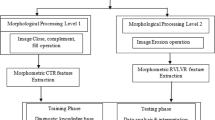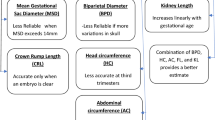Abstract
Nowadays, prediction of abnormality plays a vital role in healthcare applications for deciding the treatment and guiding for proper treatment on time. The amniotic fluid is the water of the womb, and it is a strong indicator of congenital fetal anomaly. The automatic calculation of amniotic fluid index (AFI) and shape features of varying gestational periods will be useful to predict the perinatal outcome of high risk in maternity patients. Some perinatal outcomes are expected fetal weight, head circumferences and need of new-born ICU which decide the mode of delivery. These perinatal outcomes will be helpful in increasing the live birth and reducing the risk of premature delivery. The aim of this work is to identify the abnormal AFI of expectant mothers to alert the clinicians. Computer-aided diagnosis supports the clinicians in decision-making process. In the proposed work, using the training set of ultrasound images, the shape templates are developed by using deformable methods. Contour points in the edges will be helpful to find the AFI. After that, features are extracted and fuzzy logic algorithm is used to classify the given image into one of the four categories such as oligohydramnios, borderline, normal and hydramnios state for expectant mothers and their impact on fetal growth. The outcome of the proposed approach is measured in two different ways. The first outcome is that calculated AFI will be compared with the value calculated by the radiologist/clinicians, and the second outcome is that along with AFI, shape feature with contour points and gestational age are used for making decision/classification such as normal, borderline, oligohydramnios and hydramnios, and the classified results will also be compared with the expert’s opinion. The outcomes are represented quantitatively. The results proved that AFI calculated by the proposed work was matching 94% with the expert opinion and classification of test image into any one of the categories such as normal, borderline, oligohydramnios and hydramnios fetched average accuracy of prediction up to 92.5%.







Similar content being viewed by others
References
Patel A, Patel HV (2015) Role of amniotic fluid index in pregnancy outcome. IAIM 2(8):1–12
Ross MG Method and system for measuring amniotic fluid volume and/or assessing fetal weight, United States Patent 7399278 B1
Amuthadevi C (2018) Computational intelligence based medical diagnosis. J Comput Theor Nanosci 15(6):2369–2372
Ali HS (2009) Assessment of amniotic fluid index in normal pregnancy at a tertiary care hospital setting. J Ayub Med Coll Abbottabad 21(3):149–159
Tsai PY et al (2012) A new automatic algorithm to extract craniofacial measurements from fetal three-dimensional volumes. Ultrasound Obstet Gynaecol 39(6):642–647
Salahuddin S, Noda Y, Fujino T, Fujiyama C, Yukihiro NY (1998) An assessment of amniotic index among japanese (a longitudinal study). J Maternal Foetal Investig 8:31–34
Agrawal S, Agrawal V, Yadav S (2015) Comparative study of amniotic fluid index in normal & high-risk pregnancy complicated by PIH. Indian J Obstet Gynaecol Res 2(4):242–245
Madhavi K, Rao PC (2015) Clinical study of oligohydramnios, mode of delivery and perinatal outcome. IOSR J Dent Med Sci (IOSR-JDMS) 14(4):6–11
Bhagat M, Chawla I (2014) Correlation of amniotic fluid index with perinatal outcome. J Obstet Gynaecol India 64(1):32–35
Sharma N, Srinivasan KJ, Sagayaraj MB, Lal DV (2014) Foetal weight estimation methods—clinical, sonographic and MRI imaging. Int J Sci Res Publ 4(1):1–12
Georgieva P (2016) Fuzzy rule-based systems for decision-making. Eng Sci J Bulg Acad Scis 53:5–16
Costin H (2013) A fuzzy rules-based segmentation method for medical images analysis. Int J Comput Commun 8(2):196–205
Baskar M, Gnansekaran T (2017) Multi model network analysis for improved intrusion tracing towards mitigating DDoS attack. Asian J Res Soc Sci Hum 7(3):1343–1353
Baskar M, Gnansekaran T (2017) Developing efficient intrusion tracking system using region based traffic impact measure towards the denial of service attack mitigation. J Comput Theor Nanosci 14(7):3576–3582
Manoj RJ, Praveena MDA, Vijayakumar K (2018) An ACO–ANN based feature selection algorithm for big data. Clust Comput J Netw Softw Tools Appl. https://doi.org/10.1007/s10586-018-2550-z
Vijayakumar K, Arun C (2017) Automated risk identification using NLP in cloud based development environments. J Ambient Intell Hum Comput. https://doi.org/10.1007/s12652-017-0503-7
Kadam VJ, Jadhav SM, Vijayakumar K (2019) Breast cancer diagnosis using feature ensemble learning based on stacked sparse auto encoders and softmax regression. J Med Syst. https://doi.org/10.1007/s10916-019-1397-z
Zhou J, Rajapakse JC (2005) Segmentation of subcortical brain structures using fuzzy templates. Neuroimage 28:915–924
Dutta DC (2004) The placenta and the membranes: textbook of obstetrics and gynaecology including perinatology and contraception. In: Hiralal K (ed) 6th ed. New central book agency, Calcutta, India; 2004, pp 38–39
Harliana P, Rahim Ri (2017) Comparative analysis of membership function on Mamdani fuzzy inference system for decision making. J Phys Conf Ser 930:012029. https://doi.org/10.1088/1742-6596/930/1/012029
Author information
Authors and Affiliations
Corresponding author
Additional information
Publisher's Note
Springer Nature remains neutral with regard to jurisdictional claims in published maps and institutional affiliations.
Rights and permissions
About this article
Cite this article
Amuthadevi, C., Subarnan, G.M. Development of fuzzy approach to predict the fetus safety and growth using AFI. J Supercomput 76, 5981–5995 (2020). https://doi.org/10.1007/s11227-019-03099-8
Published:
Issue Date:
DOI: https://doi.org/10.1007/s11227-019-03099-8




